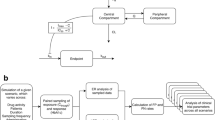Abstract
This paper presents an example of how optimal design methodology was used to help design a phase II clinical study. The planned analysis would relate the clinical endpoint to exposure (measured via the area under the curve (AUC)), rather than dose. Optimal design methodology was used to compare a number of candidate phase II designs, and an algorithm for finding optimal designs was employed. The sigmoidal Emax with baseline (E0) model was used to relate the clinical endpoint to individual subject AUCs, and the primary metrics were D optimality and the standard error (SE) of the AUC required to yield a clinically relevant change in the clinical endpoint. The performance of the candidate designs were compared across four different ‘true’ exposure response relationships (determined from the analysis of an earlier proof of concept (PoC) study). The results suggested the total sample size should be increased from the planned 540 individuals, and that the optimal design with 700 individuals would be equivalent to 812 individuals with the reference design (a 16% gain). The performance with this design was considered acceptable, although all designs performed poorly if the true exposure response relationship was very flat. This work allowed a prospective assessment of the likely performance and precision from the exposure response modelling prior to the start of the phase II study, and hence allowed the design to be revised to ensure the subsequent analysis would be of most value.





Similar content being viewed by others
References
Sheiner L (1997) Learning versus confirming in clinical drug development. Clin Pharmacol Ther 61:275–291
Exposure-response relationships: study design, data analysis, and regulatory applications. FDA Guidance for Industry, April 2003. http://www.fda.gov/downloads/Drugs/GuidanceComplianceRegulatoryInformation/Guidances/ucm072109.pdf
Gieschke R et al (1999) Relationships between exposure to saquinavir monotherapy and antiviral response in HIV-positive patients. Clin Pharmacokinet 37(1):75–86
Hutmacher MM et al (2007) Modeling the exposure-response relationship of etanercept in the treatment of patients with chronic moderate to severe plaque psoriasis. J Clin Pharmacol 47(2):238–248
Sheiner LB (1989) Clinical pharmacology and the choice between theory and empiricism. Clin Pharmacol Ther 46(6):605–615
Atkinson AC, Donev AN (1992) Optimum experimental designs. Oxford statistical science series; 8, vol xv. Oxford University Press, Oxford, 328 p
Ratkowsky DA, Reedy TJ (1986) Choosing near-linear parameters in the four-parameter logistic model for radioligand and related assays. Biometrics 42(3):575–582
Gabrielsson JL, Weiner DL (1999) Methodology for pharmacokinetic/pharmacodynamic data analysis. Pharm Sci Technol Today 2(6):244–252
Holford NH, Sheiner LB (1981) Understanding the dose-effect relationship: clinical application of pharmacokinetic–pharmacodynamic models. Clin Pharmacokinet 6(6):429–453
Matthews JN, Allcock GC (2004) Optimal designs for Michaelis–Menten kinetic studies. Stat Med 23(3):477–491
Murphy EF, Gilmour SG, Crabbe MJC (2003) Efficient and accurate experimental design for enzyme kinetics: Bayesian studies reveal a systematic approach. J Biochem Biophys Methods 55(2):155–178
Bezeau M, Endrenyi L (1986) Design of experiments for the precise estimation of the dose–response parameters: the Hill equation. J Theor Biol 123:415–430
Khinkis LA et al (2003) Optimal design for estimating parameters of the 4-parameter hill model. Nonlinearity Biol Toxicol Med 1(3):363–377
Dette H, Melas VB, Pepelyshev A (2003) Standardized maximin E-optimal designs for Michaelis–Menten model. Stat Sin 13:1147–1163
Krzyzanski W et al (2006) Assessment of dosing impact on intra-individual variability in estimation of parameters for basic indirect response models. J Pharmacokinet Pharmacodyn 33(5):635–655
Khinkis LA et al (2009) D-optimal designs for parameter estimation for indirect pharmacodynamic response models. J Pharmacokinet Pharmacodyn 36(6):523–539
Mentre F, Mallet A, Baccar D (1997) Optimal design in random-effects regression models. Biometrika 84(2):429–442
Dokoumetzidis A, Aarons L (2007) Bayesian optimal designs for pharmacokinetic models: sensitivity to uncertainty. J Biopharm Stat 17(5):851–867
Gueorguieva I et al (2006) Optimal design for multivariate response pharmacokinetic models. J Pharmacokinet Pharmacodyn 33(2):97–124
Bretz F et al (2008) Dose finding—a challenge in statistics. Biom J 50(4):480–504
Bretz F, Dette H, Pinheiro JC (2010) Practical considerations for optimal designs in clinical dose finding studies. Stat Med 29(7–8):731–742
Bretz F, Pinheiro JC, Branson M (2005) Combining multiple comparisons and modeling techniques in dose–response studies. Biometrics 61(3):738–748
Thomas N (2006) Hypothesis testing and Bayesian estimation using a sigmoid Emax model applied to sparse dose–response designs. J Biopharm Stat 16(5):657–677
Pinheiro J, Bornkamp B, Bretz F (2006) Design and analysis of dose-finding studies combining multiple comparisons and modeling procedures. J Biopharm Stat 16(5):639–656
Bornkamp B et al (2007) Innovative approaches for designing and analyzing adaptive dose-ranging trials. J Biopharm Stat 17(6):965–995
Berry DA et al (2002) Adaptive Bayesian designs for dose-ranging drug trials. Lecture Notes in Statist. In: Case studies in Bayesian statistics V. Springer, New York, pp 99–181
Golub HL (2006) The need for more efficient trial designs. Stat Med 25(19):3231–3235
Maloney A, Karlsson MO, Simonsson US (2007) Optimal adaptive design in clinical drug development: a simulation example. J Clin Pharmacol 47(10):1231–1243
Bretz F et al (2009) Adaptive designs for confirmatory clinical trials. Stat Med 28(8):1181–1217
SAS Institute Inc., Cary, NC, USA
Fedorov VV (1972) Theory of optimal experiments. Academic, New York
Billingsley P (1986) Probability and measure, 2nd edn. Wiley, New York
Acknowledgments
The authors would like to thank Leon Aarons for his valuable comments on an early draft of this manuscript, and three reviewers for their detailed observations and advice.
Author information
Authors and Affiliations
Corresponding author
Rights and permissions
About this article
Cite this article
Maloney, A., Schaddelee, M., Freijer, J. et al. An example of optimal phase II design for exposure response modelling. J Pharmacokinet Pharmacodyn 37, 475–491 (2010). https://doi.org/10.1007/s10928-010-9168-y
Received:
Accepted:
Published:
Issue Date:
DOI: https://doi.org/10.1007/s10928-010-9168-y




